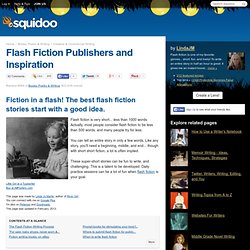

Traits.pdf. Lucy_Calkins_Texts.pdf. Stray.doc. Seedfolks.pdf. Eleven.pdf. Houseonmango.pdf. Flash Fiction Publishers and Inspiration. When I write flash fiction it usually is developed from an idea, which, as I write, morphs into a story with a beginning and middle.

I develop the character a bit, explore that character, let the character react to his or her situation, and then, miraculously, I realize what the ending should be. The whole process usually takes fifteen minutes to half an hour. Very rarely am I left without a proper ending. Fiction is amazing this way. A character pops up out of nowhere, and following that character's strongest traits, a story is created. Where the term "flash fiction" came from Nobody is certain about the origin of the term, Flash Fiction. Some believe the term 'flash fiction' came from an anthology of stories 750 words or less published in 1992.
Other names for flash fiction Short fiction has been called many things. Some call it... sudden fiction microfiction micro-story postcard fiction prosetry or a short-short story... Length of flash fiction ...that's the real issue, isn't it? ...in a flash? Prompt ideas - How to Write a Character Analysis in 10 Easy Steps. Introduction As you were reading your assigned work, you had probably been engaging in an informal character analysis without even knowing it, whether from your own opinions, text you selected to highlight, or notes that you wrote.

With a little guidance on what to do with those various notations, writing a character analysis should not be a problem! 1) Pay attention to the character’s ethics. Does the character make just or unjust choices? Consider Atticus Finch in Harper Lee’s To Kill a Mockingbird. 2) Decide whether the character’s actions are wise or unwise. 3) What is the character’s motivation? 4) Consider the effects of the character’s behavior on other characters. 5) Look for repeatedly used words that describe the character. 6) Be aware of items associated with the character. 7) Read between the lines. 8) Is the character “flat” or “round”?
9) Consider the historical time period of the character. 10) Finally, what does the author think? Scouts Honor-Student.pdf. Scouts Honor-Student.pdf. Scouts Honor.doc. More. GetFile.php?originalFile=6th_grade_literary_essay__5_21_13_w_c_right.doc&FileID=FADF3497-2B57-45B6-9E99-8318F59110FA&download=6th_grade_literary_essay__5_21_13_w_c_right. Oakland Schools English 6* (CC) / Grade 6 (Common Core) CCSS: English Language Arts 6-12, CCSS: Grade 6, Reading: Literature Key Ideas and Details 1.

Read closely to determine what the text says explicitly and to make logical inferences from it; cite specific textual evidence when writing or speaking to support conclusions drawn from the text. RL.6.1. Cite textual evidence to support analysis of what the text says explicitly as well as inferences drawn from the text.